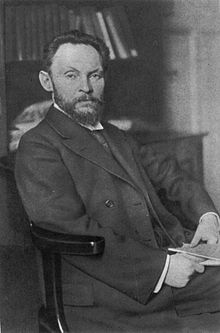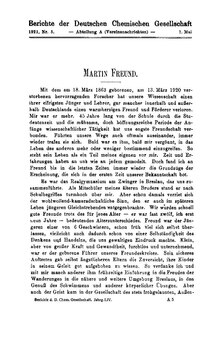Martin Freund
Martin Freund (born August 13, 1863 in Neisse ; † March 13, 1920 in Frankfurt am Main ) was a German chemist and professor at the Goethe University in Frankfurt am Main .
Life
Freund was born the son of a Jewish businessman. After graduating from the Realgymnasium am Zwinger in Breslau, he studied chemistry at the University of Breslau and the University of Berlin from 1881, and received his doctorate from the latter in 1884 (contribution to the knowledge of malonic acid). During his studies in 1881 he became a member of the Academic Natural Science Association in Breslau . He was Hermann Wichelhaus's assistant and August Wilhelm von Hofmann's lecture assistant . In 1888 he completed his habilitation in Berlin and in 1895 went to the Physikalischer Verein in Frankfurt am Main as a lecturer , where he headed its chemical laboratory. From 1905 he was a lecturer at the Academy for Social and Commercial Sciences . In 1914 he became a full professor of chemistry at the natural science faculty of the newly founded University of Frankfurt and director of the chemical institute. Freund was a confidante of Fritz Haber , to whose wife he was related.
At the Chemical Institute he maintained close ties with industry (e.g. the Cassella, Degussa, Hoechst, Metallgesellschaft companies).
plant
Freund dealt with alkaloids and clarified the composition of narcotine , for example, and contributed to the elucidation of the composition of codeine and morphine . In 1910 he found a process for the synthesis of polycarboxylic acids via a Friedel-Crafts reaction of malonic acid derivatives with aromatic hydrocarbons. Together with Edmund Speyer , he synthesized the opioid oxycodone for the first time in 1916 , which was then marketed by Merck as the pain reliever Eukodal.
Others
The Freund acid (1-naphthylamine-3,5-disulfonic acid), a coupling component of the dye chemical is erroneously assigned to Martin friend in the literature. However, the name goes back to a patent from Louis Freund (St. Ludwig, Upper Alsace) from 1883, after which it was transferred to BASF.
literature
- Entry in Winfried Pötsch, Annelore Fischer, Wolfgang Müller: Lexicon of important chemists, Harri Deutsch 1989
Individual evidence
- ↑ Report on the II. Decennium of the Acad. Natural Science Association in Breslau. Wroclaw 1894.
- ↑ Ludwig Heilbrunn: The foundation of the University of Frankfurt AM, Joseph Baer & Co 1915, p. 232.
- ^ Margit Szöllösi-Janze: Fritz Haber, 1868–1934: a biography, CH Beck, Munich 1998, p. 146, ISBN 9783406435485 .
- ↑ Physikalischer Verein Frankfurt, Historisches
- ↑ M. Freund, E. Speyer: About the conversion of thebaine into oxycodeinone and its derivatives. In: Journal for Practical Chemistry. Volume 94, number 1, 1917, pp. 135-178. doi : 10.1002 / prac.19160940112
- ^ Walther Adolf Roth in Chemiker-Zeitung , Volume 44, Dr. Alfred Hütig Verlag Heidelberg, 1920 p. 296. - Preparation from 1920
- ↑ Pötsch u. a. Lexicon important chemists, Harri Deutsch 1989, p. 157. - Alexander Sennig, Elsevier's Dictionary of Chemoethymology, 2007. - John Andraos, Named reagents, catalysts and compounds, York University 2014, pdf
- ↑ Louis Freund, Process for the preparation of amidonaphthalene disulfonic acids and of azo dyes from the same, German Patent No. 27346 of February 24, 1883 .
| personal data | |
|---|---|
| SURNAME | Friend, martin |
| BRIEF DESCRIPTION | German chemist |
| DATE OF BIRTH | August 13, 1863 |
| PLACE OF BIRTH | Neisse |
| DATE OF DEATH | March 13, 1920 |
| Place of death | Frankfurt am Main |

